Augusto Cicare Helicopter History And Timeline
1991: CH-7 Helicopter
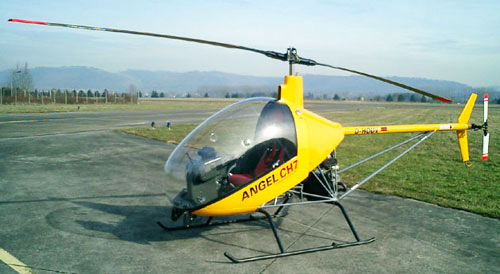
Augusto Cicare CH7 Angel helicopter
Derived from the CH-6 the CH-7 helicopter by Augusto Cicare sported a sleek new composite cabin along with many mechanical improvements in both reliability and performance.
The updated Angel CH-7 helicopter carried out flight demonstrations at Recife, Brazil on the year 1991. On 1992 the CICARE CH-7 was presented in the “Ultra-Lights International Meeting” at Bassano del Grappa, Italy and in the Oshkosh Air Show at the USA.
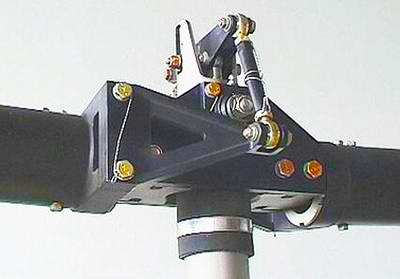
Angel CH7 Rotorhead
The CH-7 helicopter didn’t find much of a market in the USA due to its significantly higher cost when compared to other kit helicopters being offered though at the time, the price was a definate reflection of the CH-7 Angels supurb quality and refined engineering. It wasn’t long that the Angel CH-7 helicopter found a strong following through out the European countries and now it is so popular there that you can find specific CH-7 helicopter flyers clubs in many locations.
After some time the CH-7 dropped it’s two stroke Rotax 582 engine in favour of the Rotax 912 four stroke engine. While there was an instant boost in power and reliability, it didn’t take long to realise the potential of a tandem two seat version and what followed was the CH-7 Kompress including the Rotax 914 turbo charged engine.

CH7 helicopter swashplate system designed by Augusto Cicare
The CH-7 Angel was dropped from production as the Kompress helicoter, being a tandem two seater could easily be flown as a single seater. (Editors Note: There have been many experimenters adapting different engines to this chopper including rotary engines, two and four stroke engines and even turbines which marry up well to this chopper.)
Over 500 CH-7 helicopters were manufactured under licence in Italy and sold in the European market.

CH7 helicopter swash control system
VIDEO: Presentation Of The Angel CH-7 Kit Helicopter – (courtesy Beyond 2000)
VIDEO: Mangalore Airshow Flight Demonstration
1996: CICARE HELICOPTEROS S.A.
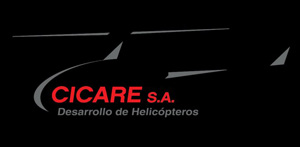
Cicare Helicopters S.A. Logo
With the purpose of supporting Mr. Cicaré in the organization and commercialization of his ingenious inventions, CICARE HELICOPTEROS S.A. was formed; where Mr. Augusto U. Cicaré is Director and technical responsible.
This allowed for a more commercialized helicopter design and development operation.
1993: CH-8 2002 VL Helicopter
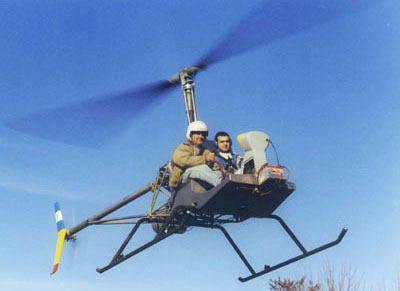
Cicare CH8 helicopter
It seemed a logical progression to the CH-8 as a result of the CH-7’s success. This prototype is a very light, two-seat two-engine helicopter. Being twin engined it was necessary to use two stokes for their lighter weight.
A feature of this helicopter is that it allows flying at the minimum power speed, with only one operative engine. It’s basic layout was based on the original CH-6 triangulated chromoly steel airframe.
While maybe seen as the next logical progression, it’s practicality is questionable to say the least. Most modern helicopters powerplants have reasonable reliability and the high fuel consumption of running twin two stroke engines would leave you wondering why just a single more reliable turbine wasn’t used.
1994: SVH-3 Training Helicopter

The unique SVH-3 training helicopter – another worlds first by Mr. Cicare
The SVH-3 is an advanced simulator-trainer of helicopter flight. It allows for reduced-cost flight training in a single seat helicopter while under the close guidance of a professional instructor.
Designed to teach and train people to become helicopter pilots safely while experiencing actual “true flight” technically, without ever leaving the ground.
The Cicare SVH-3 Helicopter flight simulator/trainer. This was awarded a gold medal for the best invention in the world at the Geneva 1999 conference
VIDEO: Cicare Helicopters SVH-3 Flight Demonstration
1996: CH-7 2000 Angel Helicopter

Augusto Cicare CH-7 2000 Angel helicopter
To give the sport flight a higher reliability, Augusto created an ultra-light, single-seat, twin-engine helicopter that could land with only one operative engine, taking the safety to the first stage.
This would have to be one of very few twin piston engine light helicopters ever conceived. While the idea behind this sleek looking design of twin engine reliability was the obvious motivation in this design, as previously mentioned, I would still question it’s practical viability.
1997: Augusto Cicare Aeronautic Award
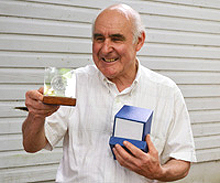
Augusto Cicare Aeronautic Spatial Engineer Award
The Professional Council of the Aeronautic and Spatial Engineering conferred to Augusto the Honorary Title of Aeronautic and Spatial Engineer, for being a reference in the field of Aeronautic Engineering all over the world.
The name “Augusto Ulderico Cicaré” appears in the outstanding aeronautical encyclopedias and manuals of every country.
Other Awards
Augusto participated with the simulator CICARE SVH-3 in the invention contest “Ladislao Jose Biro”, under the auspicious of the National Institute of the Industrial Property (INPI) and of the Argentinean Association of Inventors.
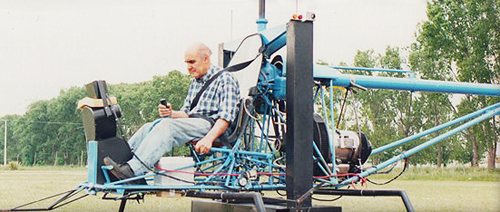
Augusto Cicare testing what looks to be an electric version of his helicopter trainer
Augusto won the first prize in the Mechanics Category and the CICARE SVH-3 was selected as the best national invention of the year, with the recognition of the Inventors International Federation (IFIA) and of the World Organization of the Intellectual Property (OMPI).
That way he represented Argentina at the International Exposition of Inventions at Geneva, Switzerland from April 30th to May 9th of 1999 obtaining the gold medal of the “P” Category (Aeronautics, Nautics, Vehicles and Accessories).
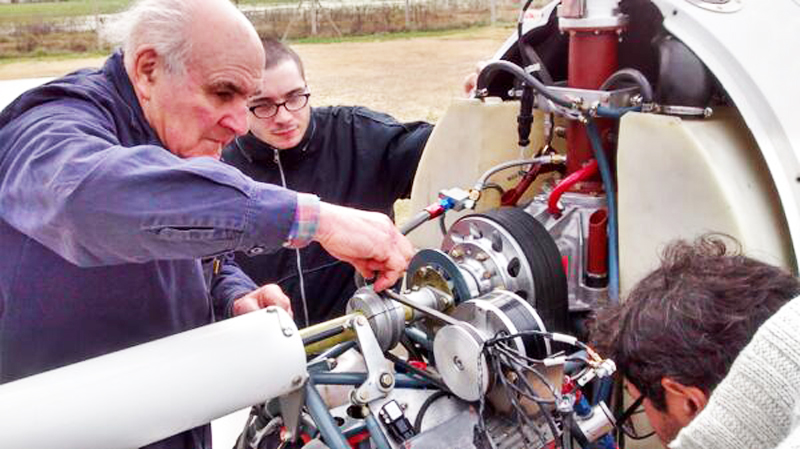
Augusto Cicare with helicopter
1997: CH-10C & CH-11S/C
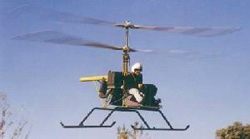
Cicare CH11s helicopter coaxial rotor system
The CH-10 is a counter-rotating single-seat twin-engine helicopter prototype with an absolutely novel control system.
In this picture we see Augusto Cicare test flying his own CH-10/CH-11 helicopter design. The prototype is powered by a Rotax 582 with the tail boom there only to maintain the proper CG during testing.
The airframe for the prototype coaxial CH-10/CH-11 helicopter is based on the CH-6, CH-7 Angel and Kompress design. This way he avoids major surgery on the frame or the additional expense just to create a new airframe that would fix the CG problem created by removing the tail boom.
So, when viewing this photo, forget the tail boom since anti torque is not needed. However, if U look closely, Senor Cicare has a little right peddle pushed in.
To maintain a heading or to turn the nose left or right, pushing in one for the peddles caused a difference in-between the normally uniform pitch setting between the two sets of counter rotating rotor systems. Simple, but I am sure not an easy task to accomplish on two rotating disks at 500 +/ – RPMs or so, in the opposite directions.
1997: CH-10C & CH-11C

Augusto Cicare CH-11C Helicopter
The CH-10C counter-rotating single-seat twin-engine helicopter with novel control system.
This helicopter was given to CITEFA (Argentine Ministry of Defense, Institute of Scientific and Technical Investigation of the Armed Forces), being for the development of a Unmanned Remote Controlled Vehicle for multiple uses.
There is little information available for this model but I must say, with it’s compact size and sleek lines, it is one good looking little machine.
Photo Credit: Sentidos
1998: CICARE SVH-3/4

Augusto Cicare SVH-4 Helicopter
Augusto participated with the simulator CICARE SVH-3 in the invention contest “Ladislao José Biró”, under the auspicious of the National Institute of the Industrial Property (INPI) and of the Argentinean Association of Inventors.
Augusto won the first prize in the Mechanics Category and the CICARE SVH-3 training helicopter was selected as the best national invention of the year, with the recognition of the Inventors International Federation (IFIA) and of the World Organization of the Intellectual Property (OMPI).
That way he represented Argentina at the International Exposition of Inventions at Geneva, Switzerland from April 30th to May 9th of 1999 obtaining the gold medal of the “P” Category (Aeronautics, Nautics, Vehicles and Accessories).

Cicare SVH4 helicopter trainer
Visit Cicare’s New SVH-4 Page – (external link)
Australian operators: Brumby Helicopters – (external link)


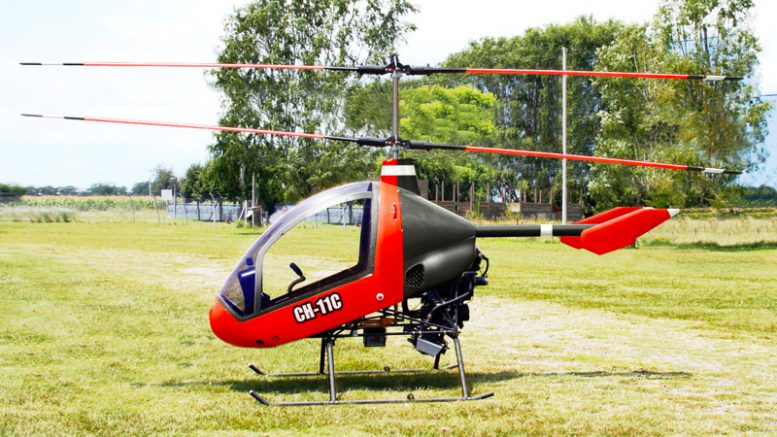
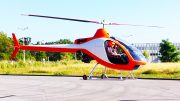
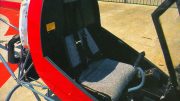
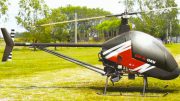
Be the first to comment on "Augusto Cicare – CH7 Angel CH8 SVh3 CH10 CH11 Helicopter"